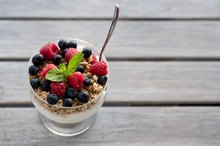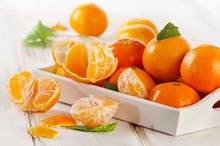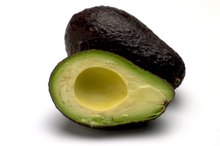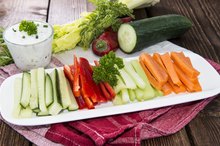Fruit Roll Up Ingredients
General Mills produces Fruit Roll-Ups, a fruit-flavored snack that resembles fruit leather in appearance and texture but not in nutritional value. Roll-Ups are gluten-free and fat-free. They are a novel snack for children and contain added vitamin C. Nutritionally, they may be a better snack than candy, but Fruit Roll-Ups don’t stack up very well when you compare them to fresh or dried fruit.
Ingredients
Ingredients in Fruit Roll-Ups as listed on the Fruit Roll-Ups Variety Pack box include pears from concentrate, corn syrup, dried corn syrup, sugar and partially hydrogenated cottonseed oil. Fruit Roll-Ups also contain 2 percent or less than 2 percent citric acid, sodium citrate, acetylated monoglycerides, fruit pectin, dextrose, maltic acid, ascorbic acid, natural flavor and the following food coloring: blue 1, red 40 and yellows 5 and 6.
Nutrition
Shelled Peanuts: Nutrition Facts
Learn More
One Fruit Roll-Up contains 50 calories. It has 1 g of fat – but no saturated or trans fat – 12 g of total carbohydrates, including 7 g of sugar, and 0 protein. A Roll-Up contains 10 percent of the recommended daily allowance of vitamin C.
Considerations
Enjoy Fruit Roll-Ups only occasionally, because they are primarily empty calories. The refined carbohydrates in this snack, which come from corn syrup and sugar, lack essential vitamins, minerals and other nutrients.
Alternatives
Ingredients in McDonald's Yogurt Parfait
Learn More
For a more nutrient-dense snack consider fresh fruit or dried fruit. For example, a half-cup of fresh pear slices contains 41 calories, 2 g of dietary fiber and 11 g carbohydrates including 6 g of sugar. Fresh pear slices also contain potassium, vitamin C and several micronutrients. A quarter cup of prunes contains 112 calories, 29 g carbohydrates including 15 g of sugar and 3 g of dietary fiber. Prunes also contain vitamin A, calcium, iron, potassium and several micronutrients.
- For a more nutrient-dense snack consider fresh fruit or dried fruit.
- Fresh pear slices also contain potassium, vitamin C and several micronutrients.
Related Articles
References
- American Journal of Clinical Nutrition: Too Much Sugar, Too Much Carbohydrate or Just Too Much?; David Jenkins, et al.; May 2004
- American Diabetes Association. Glycemic index and diabetes.
- Rizkalla SW. Health implications of fructose consumption: A review of recent data. Nutr Metab (Lond). 2010;7:82. doi:10.1186/1743-7075-7-82
- Du H, Li L, Bennett D, et al. Fresh fruit consumption in relation to incident diabetes and diabetic vascular complications: A 7-y prospective study of 0.5 million Chinese adults. PLoS Med. 2017;14(4):e1002279. doi:10.1371/journal.pmed.1002279
- Wannamethee SG, Whincup PH, Thomas MC, Sattar N. Associations between dietary fiber and inflammation, hepatic function, and risk of type 2 diabetes in older men: potential mechanisms for the benefits of fiber on diabetes risk. Diabetes Care. 2009 Oct 1;32(10):1823-5. doi:10.2337/dc09-0477
- Silva FM, Kramer CK, de Almeida JC, Steemburgo T, Gross JL, Azevedo MJ. Fiber intake and glycemic control in patients with type 2 diabetes mellitus: a systematic review with meta-analysis of randomized controlled trials. Nutr Rev. 2013;71(12):790-801. doi:10.1111/nure.12076
- Wang PY, Fang JC, Gao ZH, Zhang C, Xie SY. Higher intake of fruits, vegetables or their fiber reduces the risk of type 2 diabetes: A meta‐analysis. Journal of Diabetes Investigation. 2016 Jan;7(1):56-69. doi:10.1111/jdi.12376
- Huang H, Chen G, Liao D, et al. Effects of berries consumption on cardiovascular risk factors: A meta-analysis with trial sequential analysis of randomized controlled trials. Sci Rep. 2016;6:23625. doi:10.1038/srep23625
- Muraki I, Imamura F, Manson JE, Hu FB, Willett WC, van Dam RM, Sun Q. Fruit consumption and risk of type 2 diabetes: results from three prospective longitudinal cohort studies. BMJ. 2013 Aug 29;347:f5001.
- Harvard Health Publishing. Use glycemic index to help control blood sugar. Updated Aug. 13, 2012.
- Koloverou E, Panagiotakos DB. Macronutrient composition and management of non-insulin-dependent diabetes mellitus (NIDDM): A new paradigm for individualized nutritional therapy in diabetes patients. Rev Diabet Stud. 2016;13(1):6-16. doi:10.1900/RDS.2016.13.6
- Hosseini B, Berthon BS, Saedisomeolia A, Starkey MR, Collison A, Wark PA, Wood LG. Effects of fruit and vegetable consumption on inflammatory biomarkers and immune cell populations: a systematic literature review and meta-analysis. The American Journal of Clinical Nutrition. 2018 Jul 1;108(1):136-55. doi:10.1093/ajcn/nqy082
- Cooper AJ, Sharp SJ, Lentjes MA, Luben RN, Khaw KT, Wareham NJ, et al. A prospective study of the association between quantity and variety of fruit and vegetable intake and incident type 2 diabetes. Diabetes Care2012;35:1293-300. doi:10.2337/dc11-2388
- Basu A, Rhone M, Lyons TJ. Berries: emerging impact on cardiovascular health. Nutr Rev. 2010;68(3):168-177. doi:10.1111/j.1753-4887.2010.00273.x
- Mahmoud AM, Hernández Bautista RJ, Sandhu MA, Hussein OE. Beneficial effects of citrus flavonoids on cardiovascular and metabolic health. Oxid Med Cell Longev. 2019;2019:5484138. doi:10.1155/2019/5484138
- Centers for Disease Control and Prevention. Carb Choices. Updated March 21, 2019.
- American Diabetes Association. Glycemic index and diabetes.
- Wang PY, Fang JC, Gao ZH, Zhang C, Xie SY. Higher intake of fruits, vegetables or their fiber reduces the risk of type 2 diabetes: A meta‐analysis. Journal of Diabetes Investigation. 2016 Jan;7(1):56-69. doi:10.1111/jdi.12376
Writer Bio
Ann Wolters has been a writer, consultant and writing coach since 2008. Her work has appeared in "The Saint Paul Almanac" and in magazines such as "Inventing Tomorrow" and "Frontiers." She earned a Master of Arts in English as a second language from the University of Minnesota.









